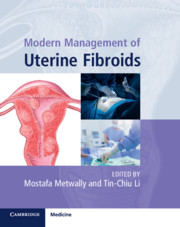Book contents
- Modern Management of Uterine Fibroids
- Modern Management of Uterine Fibroids
- Copyright page
- Contents
- Contributors
- Foreword
- Chapter 1 Pathophysiology of Uterine Fibroids
- Chapter 2 Evaluation of Uterine Fibroids Using Two-Dimensional and Three-Dimensional Ultrasonography
- Chapter 3 Ulipristal and Other Medical Interventions for Treatment of Uterine Fibroids
- Chapter 4 The Role of Magnetic Resonance Imaging in the Management of Fibroids
- Chapter 5 Fibroids and Fertility
- Chapter 6 Fibroids and Reproduction
- Chapter 7 Open Myomectomy
- Chapter 8 Laparoscopic and Robotic Myomectomy
- Chapter 9 Principles and Technique of Laparoscopic Myomectomy
- Chapter 10 Uterine Fibroids
- Chapter 11 Total Laparoscopic Hysterectomy for the Fibroid Uterus
- Chapter 12 Hysteroscopic Resection of Submucosal Fibroids
- Chapter 13 Modern Management of Intramural Myomas
- Chapter 14 Outpatient Myomectomy
- Chapter 15 Vaginal Hysterectomy with Fibroids
- Chapter 16 Leiomyosarcoma
- Chapter 17 MRI-Guided Ultrasound Lysis of Fibroids
- Chapter 18 Embolization for the Management of Uterine Fibroids
- Chapter 19 Uterine Fibroids in Postmenopausal Women
- Appendix: Video Captions
- Index
- References
Chapter 12 - Hysteroscopic Resection of Submucosal Fibroids
Published online by Cambridge University Press: 10 October 2020
- Modern Management of Uterine Fibroids
- Modern Management of Uterine Fibroids
- Copyright page
- Contents
- Contributors
- Foreword
- Chapter 1 Pathophysiology of Uterine Fibroids
- Chapter 2 Evaluation of Uterine Fibroids Using Two-Dimensional and Three-Dimensional Ultrasonography
- Chapter 3 Ulipristal and Other Medical Interventions for Treatment of Uterine Fibroids
- Chapter 4 The Role of Magnetic Resonance Imaging in the Management of Fibroids
- Chapter 5 Fibroids and Fertility
- Chapter 6 Fibroids and Reproduction
- Chapter 7 Open Myomectomy
- Chapter 8 Laparoscopic and Robotic Myomectomy
- Chapter 9 Principles and Technique of Laparoscopic Myomectomy
- Chapter 10 Uterine Fibroids
- Chapter 11 Total Laparoscopic Hysterectomy for the Fibroid Uterus
- Chapter 12 Hysteroscopic Resection of Submucosal Fibroids
- Chapter 13 Modern Management of Intramural Myomas
- Chapter 14 Outpatient Myomectomy
- Chapter 15 Vaginal Hysterectomy with Fibroids
- Chapter 16 Leiomyosarcoma
- Chapter 17 MRI-Guided Ultrasound Lysis of Fibroids
- Chapter 18 Embolization for the Management of Uterine Fibroids
- Chapter 19 Uterine Fibroids in Postmenopausal Women
- Appendix: Video Captions
- Index
- References
Summary
Fibroids represent an extremely common benign uterine pathology, being a major cause of abnormal uterine bleeding disorders. Although most myomas are of benign origin, it is important to have a correct diagnostic procedure prior to endoscopic myoma resection. Preoperative imaging techniques as well as histological criteria have to be taken into account. The true prevalence of uterine sarcoma in presumed fibroids is not known, given the wide range of prevalence (0.014–0.45%) from meta-analyses mainly based on retrospective trials. Age and certain imaging characteristics are associated with a higher risk of uterine sarcoma, although the risks remain low [1, 2].
- Type
- Chapter
- Information
- Modern Management of Uterine Fibroids , pp. 104 - 125Publisher: Cambridge University PressPrint publication year: 2020



